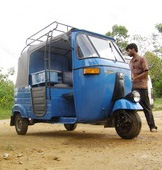eTUKTUK takes internet and radio to Sri Lankan villages
09-05-2006 (New Delhi)

Self-contained mobile telecentre
and radio broadcasting unit
© eTUKTUK
In the hilly region of Kothmale in central Sri Lanka, the tuk-tuk, the three wheeled motorcycle, which is a favoured form of local transport common in South Asia, is all set to take a new form as a self-contained mobile telecentre.
Kothmale Community Radio (KCR) has devised a new innovative approach of content delivery and radio production, in line with the station’s commitment to increasing access and participation to new and traditional ICTs and providing voice and expression to the community it serves.
The eTUKTUK is a self-contained mobile telecentre and radio broadcasting unit which travels into remote villages in the Kothmale region and provide communities the opportunity to participate in the KCR’s programming as well as have access to new digital technologies and internet.
The eTUKTUK contains a laptop computer, battery operated printer, camera, telephone and scanner. Internet is provided via a CDMA enabled wireless connection and electricity is provided via a generator. A roof rack allows the vehicle to carry other equipment such as the Kothmale Community Radio Station’s mobile broadcasting unit. Narrowcasting of radio programs is done using the two loud speakers mounted to the roof rack. This system is used to announce the telecentre’s presence when it arrives in a village or designated location. The weekly route of the eTUKTUK is broadcast over the radio to inform the listeners about the location and time that it will arrive in their community.
The mobile design of the eTUKTUK provides access to the most geographically remote areas of the Kothmale region. The objective of the project is to serve those sections of the community marginalised through gender, caste, ethnicity and other factors that make participants feel they have no proper place in ICTs and ICT initiatives. By providing internet access directly to the villages and presenting it to users in a familiar environment, the technology is made less daunting. Those who are unable or unwilling to travel large distances can also benefit from the experience. With the assistance of trained operators, the barriers of language and illiteracy can be overcome and the benefits can be focused on the most disadvantaged in the community.
“Lots of people in this area don’t even know what the internet is. I think the etuktuk is a really good way to introduce and improve our knowledge about information technology and the narrowcasting gives a voice to local people and all of us in the community,” says Buddhika Darshana of Kothmale CMC.
The eTUKTUK was officially launched at the Kothmale Community Radio Station on the 29th of April 2006 and is supported by UNESCO in collaboration with MJF Charitable Foundation, Suntel and Pan Asia ICT Research and Development project.
The Kothmale CMC in Sri Lanka combines radio broadcasting with telecentre and training facilities. The station originated ‘radio browsing’, a format that brings internet to radio listeners through an innovative combination of technologies. The CMC roughly serves a population of 200,000 people in some sixty villages.
By Benjamin Grubb, Project Advisor, UNESCO
The eTUKTUK is a self-contained mobile telecentre and radio broadcasting unit which travels into remote villages in the Kothmale region and provide communities the opportunity to participate in the KCR’s programming as well as have access to new digital technologies and internet.
The eTUKTUK contains a laptop computer, battery operated printer, camera, telephone and scanner. Internet is provided via a CDMA enabled wireless connection and electricity is provided via a generator. A roof rack allows the vehicle to carry other equipment such as the Kothmale Community Radio Station’s mobile broadcasting unit. Narrowcasting of radio programs is done using the two loud speakers mounted to the roof rack. This system is used to announce the telecentre’s presence when it arrives in a village or designated location. The weekly route of the eTUKTUK is broadcast over the radio to inform the listeners about the location and time that it will arrive in their community.
The mobile design of the eTUKTUK provides access to the most geographically remote areas of the Kothmale region. The objective of the project is to serve those sections of the community marginalised through gender, caste, ethnicity and other factors that make participants feel they have no proper place in ICTs and ICT initiatives. By providing internet access directly to the villages and presenting it to users in a familiar environment, the technology is made less daunting. Those who are unable or unwilling to travel large distances can also benefit from the experience. With the assistance of trained operators, the barriers of language and illiteracy can be overcome and the benefits can be focused on the most disadvantaged in the community.
“Lots of people in this area don’t even know what the internet is. I think the etuktuk is a really good way to introduce and improve our knowledge about information technology and the narrowcasting gives a voice to local people and all of us in the community,” says Buddhika Darshana of Kothmale CMC.
The eTUKTUK was officially launched at the Kothmale Community Radio Station on the 29th of April 2006 and is supported by UNESCO in collaboration with MJF Charitable Foundation, Suntel and Pan Asia ICT Research and Development project.
The Kothmale CMC in Sri Lanka combines radio broadcasting with telecentre and training facilities. The station originated ‘radio browsing’, a format that brings internet to radio listeners through an innovative combination of technologies. The CMC roughly serves a population of 200,000 people in some sixty villages.
By Benjamin Grubb, Project Advisor, UNESCO
Related themes/countries
· Sri Lanka: News Archive 2006
· 2006
· Access to Information: News Archives 2006
Share this story:
Contact information
-
Contact
- Jocelyne Josiah, Advisor for Communication and Information, UNESCO Office in New Delhi
- Seema Nair, CMC Asia Coordinator
- UNESCO
Source
- UNESCO Office New Delhi
Field office














